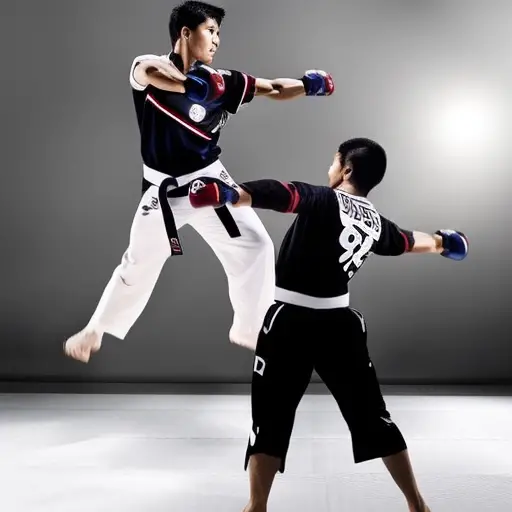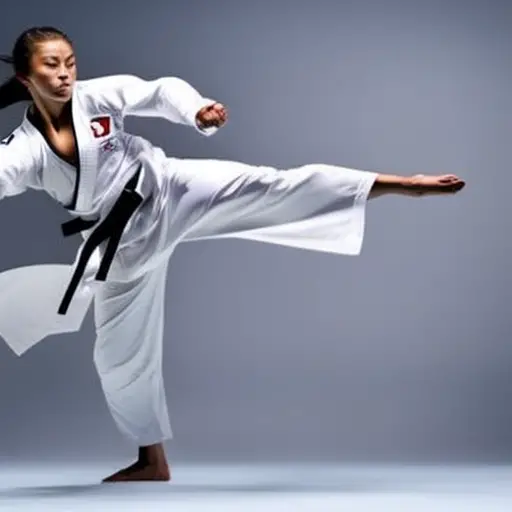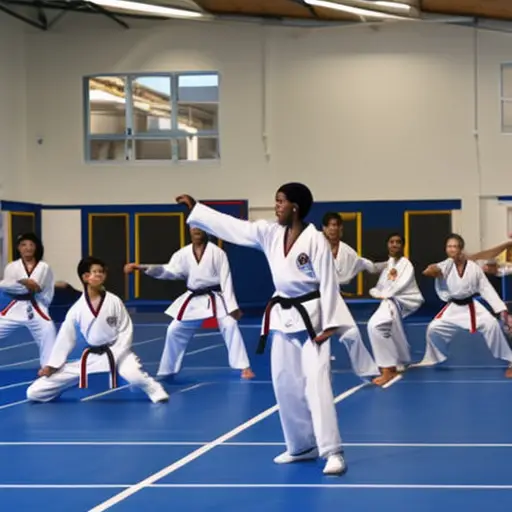Overcoming Physical Challenges With Adaptive Taekwondo

Like a beacon of hope in the face of adversity, adaptive taekwondo emerges as a transformative practice for individuals overcoming physical challenges. With tailored techniques and modifications, this martial art offers a path towards empowerment and resilience.
From mobility impairments to visual limitations, adaptive taekwondo paves the way for personal growth and achievement.
Join us as we explore the world of adaptive taekwondo, where strength knows no bounds and triumphs are forged through determination and adaptability.
The Benefits of Adaptive Taekwondo for Physical Challenges
One of the key benefits of Adaptive Taekwondo for individuals with physical challenges is the improvement in flexibility and strength. Modified forms and specialized techniques are used to accommodate the unique needs of students with physical limitations, allowing them to participate and experience the numerous advantages of this martial art.
Adaptive Taekwondo emphasizes flexibility training as an essential component of its practice. Through a variety of stretches and exercises, students gradually increase their range of motion, promoting enhanced flexibility in their joints and muscles. This increased flexibility not only helps individuals with physical challenges to move more freely, but it also reduces the risk of injuries and muscle strains.
In addition to flexibility, balance training is another significant benefit of Adaptive Taekwondo. Students learn various techniques and exercises that improve their balance and stability, which can be particularly beneficial for individuals with physical challenges. By strengthening their core muscles and practicing specific balance drills, students can enhance their overall stability and coordination.
The combination of improved flexibility and balance not only contributes to the physical well-being of individuals with physical challenges but also enhances their confidence and self-esteem. As they witness their progress and capabilities through Adaptive Taekwondo, they gain a sense of empowerment and accomplishment, leading to improved overall quality of life.
Techniques and Modifications for Mobility Impairments in Taekwondo
When practicing Taekwondo with mobility impairments, modified kicks can be utilized to accommodate different disabilities. These modifications allow individuals with limited mobility to still participate and benefit from the martial art.
Additionally, equipment adaptations can be made to ensure accessibility for those with mobility impairments, such as the use of assistive devices or modifications to training equipment.
Modified Kicks for Disabilities
Significantly, individuals with mobility impairments can still perform modified kicks in Taekwondo through techniques and modifications tailored to their specific needs. Inclusive training approaches in adaptive Taekwondo focus on providing equal opportunities for individuals with disabilities to participate in the sport. Modified kicks allow individuals with mobility impairments to engage in the dynamic and powerful movements that characterize Taekwondo.
One technique commonly used is the seated kick, where individuals perform kicks while seated on the ground or in a chair. This modification allows individuals with limited mobility in their lower limbs to still execute kicks with precision and power. Another modification is the use of assistive devices such as crutches or prosthetics, which provide support and stability during kicks. Additionally, individuals with upper limb impairments can adapt their techniques by using their arms or other parts of their body to compensate for limited lower limb mobility.
By implementing these modifications, individuals with mobility impairments can fully participate in Taekwondo and experience the physical, mental, and emotional benefits of the sport. These modifications not only enhance inclusivity but also empower individuals to overcome their physical challenges and achieve their goals in Taekwondo.
Transitioning into the subsequent section about equipment adaptations for accessibility, it is essential to explore how adaptive equipment can further enhance the participation of individuals with disabilities in Taekwondo.
Equipment Adaptations for Accessibility
Enhancing accessibility and inclusivity, adaptive Taekwondo utilizes equipment adaptations and modifications to accommodate individuals with mobility impairments. These adaptations are crucial in ensuring that everyone, regardless of their physical abilities, can fully participate in and benefit from Taekwondo training.
Adaptive Taekwondo equipment modifications include the use of assistive devices such as wheelchairs, crutches, or braces, which allow individuals with mobility impairments to perform various techniques and movements. Additionally, training mats with non-slip surfaces and padding are used to provide stability and prevent injuries. The use of specialized equipment like kicking targets at different heights and angles also helps individuals with mobility impairments to practice and improve their skills.
By making these modifications, adaptive Taekwondo promotes accessibility in training and empowers individuals with mobility impairments to engage in the art form, gain confidence, and enhance their overall physical well-being.
Transitioning into the subsequent section, let’s explore how adaptive Taekwondo training can enhance the experience for individuals with visual impairments.
Enhancing Visual Impairments Through Adaptive Taekwondo Training
When it comes to enhancing visual impairments through adaptive Taekwondo training, there are several key adaptations that can be made to accommodate individuals with visual challenges.
These adaptations may include auditory cues, tactile feedback, and modified training techniques that rely on other senses.
Visual Impairment Adaptations
Through the use of specialized techniques and training methods, individuals with visual impairments can benefit from adaptive Taekwondo to enhance their physical abilities and overall well-being. Taekwondo, a martial art that focuses on high kicks, quick strikes, and precise movements, can be adapted to accommodate various visual impairments.
Here are three ways in which adaptive Taekwondo training can enhance the lives of individuals with visual impairments:
-
Auditory Cues: Instructors can incorporate auditory cues, such as verbal commands or sounds, to help individuals with visual impairments execute techniques accurately. This allows them to rely on their sense of hearing to follow instructions and engage fully in the training.
-
Tactile Feedback: By emphasizing physical contact and providing tactile feedback during training, individuals with visual impairments can better understand and execute techniques. This can be achieved through partner drills or the use of tactile markers on training equipment.
-
Inclusive Training Environment: Adaptive Taekwondo classes promote inclusion by creating a supportive and inclusive training environment. Instructors and fellow students are trained to be understanding, patient, and accommodating, ensuring that individuals with visual impairments feel welcomed and valued.
Benefits of Martial Arts
Additionally, martial arts training offers a multitude of benefits for individuals with visual impairments. Not only does it provide a way to stay physically active and improve overall fitness, but it also enhances confidence and self-defense skills. Through adaptive Taekwondo training, individuals with visual impairments can overcome their physical challenges and gain a sense of empowerment.
One of the key benefits of martial arts for individuals with visual impairments is improved confidence. The structured nature of martial arts training, combined with the focus on discipline and self-improvement, can help individuals build confidence in their abilities. The challenges and achievements they experience in training can translate into increased self-esteem and belief in their own capabilities.
Moreover, martial arts training equips individuals with visual impairments with self-defense skills. Learning techniques for protecting oneself can provide a sense of security and empowerment. It allows individuals to feel more confident and capable of handling potentially dangerous situations.
Incorporating adaptive Taekwondo training specifically for individuals with visual impairments can be even more beneficial. By modifying techniques and using specialized tools, instructors can ensure that individuals with visual impairments can fully participate and reap the rewards of martial arts training.
Below is a table highlighting some of the specific benefits of martial arts training for individuals with visual impairments:
| Benefits of Martial Arts Training for Visual Impairments |
|---|
| Improved confidence |
| Enhanced self-defense skills |
| Increased physical fitness |
| Greater body awareness |
| Improved concentration and focus |
Overcoming Strength and Endurance Limitations in Taekwondo
Regularly incorporating targeted strength and endurance training into taekwondo practice can help individuals overcome limitations in these areas and improve their overall performance. Adaptive training techniques can be implemented to tailor the training program to the specific needs and abilities of each individual. Here are three ways in which strength and endurance limitations can be overcome in taekwondo:
-
Progressive Resistance Training: By gradually increasing the resistance in exercises such as weightlifting or resistance band training, individuals can build strength and endurance over time. This allows them to gradually push their limits and improve their performance in taekwondo techniques.
-
High-Intensity Interval Training (HIIT): Incorporating HIIT into taekwondo training can help improve both strength and endurance. By alternating between short bursts of intense activity and brief recovery periods, individuals can improve their cardiovascular fitness and increase their overall endurance levels.
-
Plyometric Exercises: Plyometric exercises, such as box jumps or explosive push-ups, can help develop explosive power and improve overall strength. These exercises involve rapid muscle contractions, which can enhance the speed and power of taekwondo techniques.
By implementing these training methods, individuals can enhance their strength and endurance, allowing them to perform better in taekwondo.
Transitioning into the subsequent section, the use of adaptive taekwondo equipment and gear can further assist individuals in overcoming physical challenges and maximizing their performance.
Adaptive Taekwondo Equipment and Gear for Physical Challenges
Utilizing specialized adaptive taekwondo equipment and gear can empower individuals with physical challenges to overcome obstacles and fully participate in the martial art. Inclusive taekwondo classes for physical challenges aim to provide a safe and supportive environment for practitioners of all abilities. Adaptive taekwondo training techniques, coupled with the right equipment, can enhance the experience for these individuals, enabling them to reach their full potential.
One of the key aspects of adaptive taekwondo equipment is its ability to accommodate various physical limitations. For example, individuals with limb differences may require prosthetic devices that are designed specifically for taekwondo training. These devices are lightweight, flexible, and provide stability and support during kicks and movements.
Another important piece of equipment is the padded sparring gear. This gear is essential for individuals with physical challenges as it offers protection and reduces the risk of injury during training sessions and competitions. The gear is designed to be comfortable and adjustable, ensuring a proper fit for each individual.
Adaptive taekwondo equipment also includes assistive devices such as balance aids, handrails, and harnesses. These aids provide additional support and stability, helping individuals with physical challenges maintain balance and perform movements with confidence.
Success Stories of Individuals Overcoming Physical Challenges With Adaptive Taekwondo
Furthermore, many individuals with physical challenges have successfully overcome their limitations through the practice of adaptive Taekwondo. This martial art form has proven to be a transformative and empowering tool for people with cognitive disabilities and neurological disorders. Here are three inspiring success stories that highlight the incredible impact of adaptive Taekwondo:
-
John’s Triumph Over Autism: John, a teenager diagnosed with autism, struggled with communication and social interaction. However, after joining an adaptive Taekwondo program specifically designed for individuals with cognitive disabilities, he experienced significant improvements. Through the structured routines and discipline of Taekwondo, John gained confidence, improved his focus, and developed better social skills. He even went on to participate in local tournaments, showcasing his newfound abilities.
-
Sara’s Battle with Parkinson’s Disease: Sara was diagnosed with Parkinson’s disease, which affected her balance, coordination, and mobility. Determined to regain control over her body, she turned to adaptive Taekwondo. Through specialized exercises and modified techniques, Sara not only improved her physical strength and flexibility but also experienced a boost in her overall well-being. Taekwondo became a vital part of her Parkinson’s management plan, allowing her to maintain an active lifestyle.
-
Alex’s Journey with Cerebral Palsy: Alex, a young boy with cerebral palsy, faced challenges with muscle coordination and motor skills. However, his involvement in adaptive Taekwondo transformed his life. Through tailored training and adaptive techniques, Alex gradually gained strength, balance, and coordination. Taekwondo not only improved his physical abilities but also boosted his self-esteem and confidence. Alex’s progress in Taekwondo has been a source of inspiration for many others facing similar challenges.
These success stories demonstrate the remarkable impact of adaptive Taekwondo on individuals with cognitive disabilities and neurological disorders. Through its unique blend of physical exercise, mental focus, and emotional growth, Taekwondo provides a platform for personal development and triumph over physical challenges.
Frequently Asked Questions
How Long Does It Take to See Improvements in Physical Challenges Through Adaptive Taekwondo Training?
The timeline for improvement in physical challenges through adaptive taekwondo training varies depending on individual abilities and disabilities. However, adaptive taekwondo has shown significant benefits for individuals with various disabilities, promoting physical strength, confidence, and overall well-being.
Are There Any Age Limitations for Participating in Adaptive Taekwondo?
There are no age limitations for participating in adaptive taekwondo. This martial art offers benefits to individuals of all age groups, promoting physical fitness, mental discipline, and self-confidence.
Is It Necessary to Have Previous Martial Arts Experience Before Starting Adaptive Taekwondo?
Previous martial arts experience is not necessary to start adaptive taekwondo. The practice offers numerous benefits for individuals without martial arts experience, including improved physical fitness, self-confidence, and stress relief.
Can Adaptive Taekwondo Help With Mental Health Challenges in Addition to Physical Ones?
Adaptive taekwondo can indeed help with mental health challenges in addition to physical ones. The practice of adaptive taekwondo has been shown to provide numerous benefits for mental well-being, including increased self-confidence, improved focus, stress reduction, and enhanced emotional well-being.
Are There Any Specific Safety Precautions or Considerations to Keep in Mind When Practicing Adaptive Taekwondo for Physical Challenges?
When practicing adaptive Taekwondo for physical challenges, it is essential to prioritize safety precautions and implement training modifications. By taking these measures, individuals can participate in the sport effectively and reduce the risk of injury.
Conclusion
In conclusion, adaptive taekwondo offers numerous benefits for individuals facing physical challenges. By incorporating techniques and modifications tailored to mobility impairments, visual impairments, and strength and endurance limitations, individuals can overcome these obstacles and achieve success in taekwondo.
With the right equipment and gear, adaptive taekwondo becomes accessible to everyone, regardless of their physical limitations. Through the inspiring success stories of individuals who have overcome their physical challenges, adaptive taekwondo serves as a powerful tool for empowerment and personal growth.





